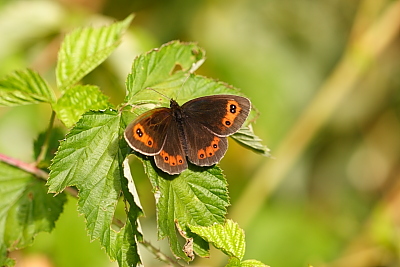
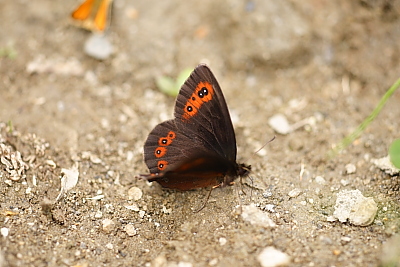
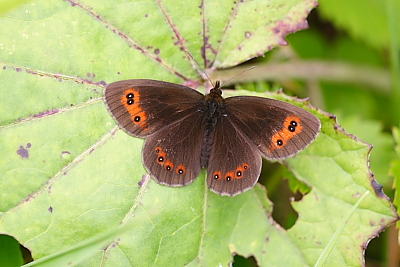
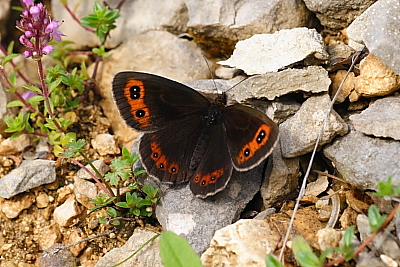

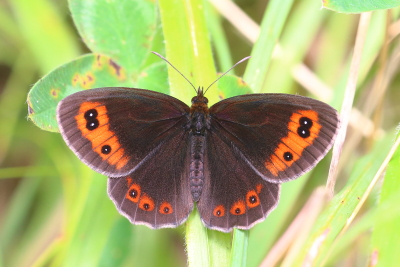
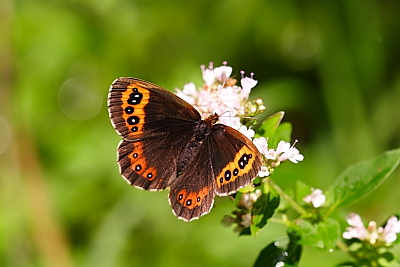
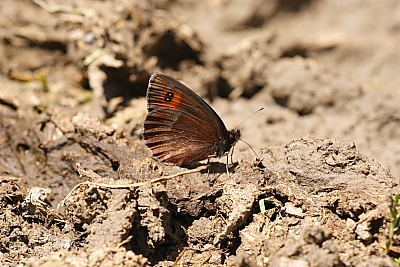
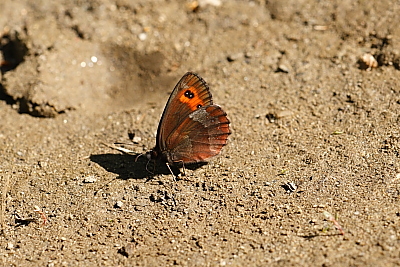
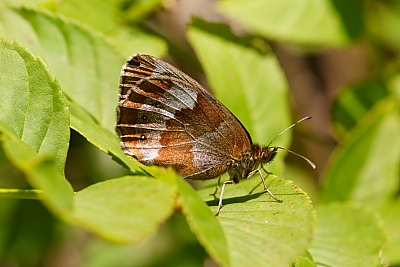
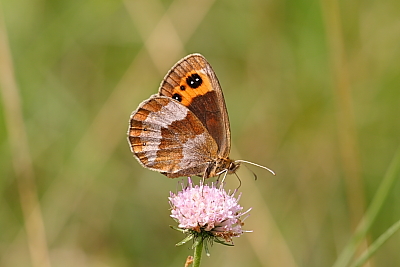
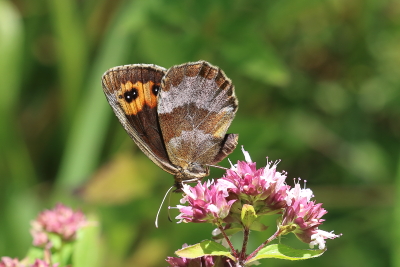
Scotch
Argus
2023 photographs highlighted in green. Click on any photograph to go to an enlarged picture, or simply scroll down the page.
|
The upf post-discal band is bright red, and the ground colour is dark brown to black with velvety appearance, especially in the male, more so when fresh when the patch of androconial (scent) scales area is clearly darker. The red post-discal band is often constricted at s3 with clear white-pupilled ocelli in s2, s4 and s5, and possibly a smaller one in s3.
The band often appears to "hug" the ocelli in s4 and s5 and form almost a red circle around these ocelli. The red band is usually slightly cut at the veins and the external edges are sometimes concave. The uph red marks are usually discrete and often straight edged at the base with the ocelli almost touching the lower edges. The female upf red band is often wider and the ocelli larger. |
The unh post-discal band is
usually sufficiently defined in the male, having a speckled or "irrorated"
appearance, shown in most books as more distinctive than those on this page.
The female underside is generally lighter and the post-discal band better
contrasted. Lafranchis
says the defining aethiops characteristic is the unh series of three to four small white
spots, but I have seen specimens that have only one, in s2.
The subtitle of his identification book is "Identifying butterflies is easy", and whilst the book is excellent and a must for all butterfly enthusiasts, the variability of species often makes identification very difficult, if not impossible. Aethiops is not uncommon in suitable mountainous regions, but also occurs at much lower altitudes than most other Erebia (Lafranchis says 200m) in central and eastern France. In 2014 it was exceptionally common in July in eastern France. |
| ref | sex |
observations |
alt. m |
| 18051 | M |
a rather more typical upf post-discal band, "hugging" the ocelli and "waisted" (albeit only slightly) in s3. |
1120 |
| 18182 | M |
I am not 100% certain that this is aethiops, but the black velvety appearance of the upf suggests that it is, the upf red band rather hugs the ocelli (albeit rather wide around the ocelli in s4 and s5). The fact that the vein cuts the band between s2 and s3 is slightly indicative of the Piedmont Ringlet (E. meolans) but in meolans, the post-discal band is more clearly broken into sections. The uph red marks are unusually round and discrete and the ocelli equally unusually centred within them. |
1120 |
| 27844 | M | a classic male aethiops, the upf post-discal red band being nice and rounded, following the contours of the ocelli and constricting in the middle at s3. | 1150 |
| 36631 | M | a very fresh male, almost jet black and with a particularly velvety appearance. | 370 |
| 50218 | M | a fairly fresh male, even for late July (in an "early" season), and very black. | 320 |
| 50223 | M | a very fresh male, seen on the same day as 50218. A very appealing specimen. | 320 |
| 36598 | F | a female, with a complete set of six ocelli and those in s2/4/5/ are very large indeed. The red post-discal band is very wide and 36598 looks nothing like the female illustrated in T&L. | 320 |
| 23333 | M |
a male, two of the white spots clearly visible, the other two being poorly developed. The post-discal band is a little more distinct here than it is 18058. |
1850 |
| 18058 | M |
probably more typical of a male underside, with the post-discal band being clear. Enough of the unf red band can be seen to show how the band is constricted at s3 as it is on the upf. |
1120 |
| 27506 | F | a female, with clear contrast between the unh bands, and two strongish (for a female) ocelli in s2 and s3. | 1120 |
| 36584 | F | a female, nicely showing the contrast between the unh bands. | 320 |
| 47770 | F | a female, also showing the unh contrasted bands, but without any vestige of ocelli. | 320 |
36598_female_Côte-d'Or_25Jul14
23333_male_Vaud, Switzerland_27Jul10
36584_female_Côte-d'Or_25Jul14
47770_female_Côte-d'Or_29Jul20